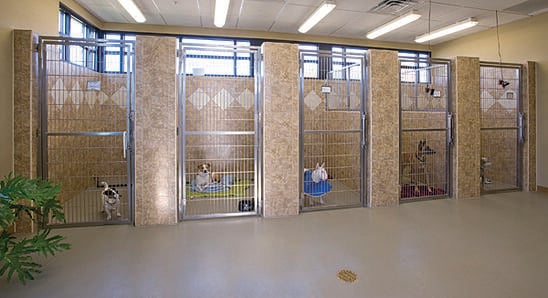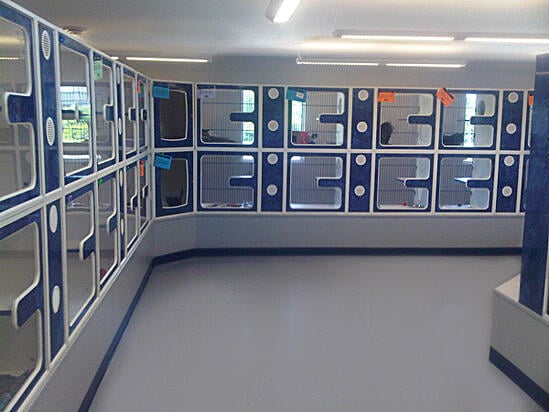The best boarding facilities and services are designed with pets—and their owners—in mind.
By Kristi Reimer

When clients bring their pets to your boarding facility, do they look worried, apprehensive, or guiltridden? If so, then you’ve got work to do. Your facility and services need to elicit smiles from pet owners who feel perfectly comfortable leaving their “family members” in your care. Much of that hinges on what clients smell, hear, and see.
Wipe Out Odor
One of the biggest client turnoffs is odor, says E. John Knapp, AIA, an architect specializing in kennel design. If you have concrete floors, give your kennel this test right now: Pour some water on the floor. If the floor turns dark, that means the concrete has absorbed the urine, and odors will follow. The worst part: “Concrete smells last forever,” says Knapp.
One solution is to cover the concrete so that it can’t absorb liquid. Knapp recommends glazed quarry tile with epoxy grout joints, but less costly materials are also available. One practical strategy is to use commercial-grade sheet vinyl. Install the flooring with the room empty, roll it 6 to 8 inches up the sides of the walls without a cut at the base, and place the kennels and runs on top. If it’s necessary to create seams, have them sealed with heat because chemically sealed joints tend to loosen over time.
Another essential element of an odor-free facility is ventilation. According to Knapp, a big fan that sucks air out of the room doesn’t exhaust the air properly. He recommends using the same type of heating and air conditioning systems found in office buildings. “They pump fresh air in and bad air out,” Knapp says. “Plus, clients want clean air and comfortable temperatures for their pets.”
Knock Out Noise
To control the barking frenzy, Knapp has a simple solution: Treat the entire ceiling and top section of the walls above the doors with a spray-on cellulose material called K-13 (see www. spray-on.com). This substance, which comes in six colors, absorbs sound and keeps it from reverberating around the room. If you’re designing a new facility, Knapp recommends at least 12-foot ceilings, which provide even better sound control.
You also need to consider sound control from room to room and from inside to outside. Contrary to popular belief, a regular wall with fiberglass insulation does not muffle enough sound for most kennels or city planning commissions, Knapp says. The average wall stops up to 35 decibels, and most cities require sound control of 50 to 55 decibels. Drywall manufacturers produce dozens of standard walls with various sound transmission classes, so consult an architect or builder to help you
make the appropriate choice.
Pay Attention to Appearance
As many retailers have discovered, one of the most important considerations for drawing and keeping customers is an attractive building, both inside and out. “Just think about the new Target stores,” Knapp says. “Target has figured out the importance of a goodlooking building.”
For the interior, think open, airy, and sunshiny. Your boarding space should look bigger than it is, and high ceilings and lots of windows can help accomplish this. In addition, clients like bright and cheery colors, which give an impression of cleanliness. Some practice owners have even hired artists to paint murals on the walls.

Keep Cats Content
A big hit with felines, Knapp says, are floor-to-ceiling cat condos with shelves at various heights and large windows to indulge the occupants’ birdchasing fantasies. “No cat—or cat owner—is happy with a 30-inch cage,” Knapp says.
One of Knapp’s clients in New Mexico found success with a bagel-shaped cat kennel built around a center atrium. The exterior walls are glass, so cats in the condos around the outside of the building can look out, and cats around the inside can look into the atrium. “The public is nuts about this facility,” Knapp says. “The owner built 40 condos, and, on average, 80% are occupied. It has made for happy cats and happy customers.”
All in all, Knapp says, if practitioners start thinking like retailers, figuring out what customers want and giving it to them instead of cutting costs at every corner, the public will respond with enthusiasm. “One of my clients built a beautiful 15,000-square-foot kennel with all the luxuries, and he broke even in three months,” Knapp says. “It’s a whole different attitude that pays off in the end.”

